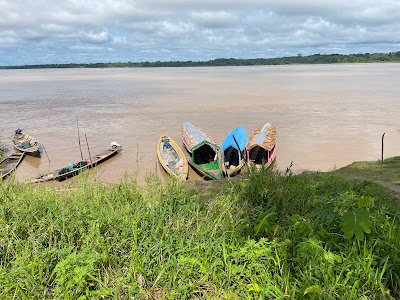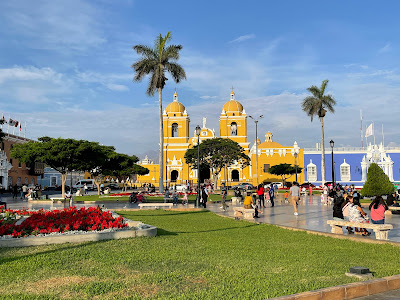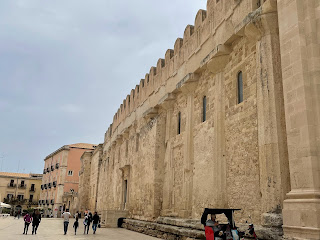My friend, Glenda, and I decided to escape winter by going to Peru from mid-January to mid- February where temperatures are in the upper 20’s C/ 70’s and 80’s F. We had planned a four week trip, and it was a great trip until the very end when the day before we were leaving Glenda fell and fractured her hip in two places and her femur. For over a week Glenda was in a private clinic in a nice suburb of Lima receiving care. After six days, I returned home because I didn’t feel that I could help Glenda anymore, and she returned to Victoria, BC several days later with an attending nurse. She is home in Victoria, BC recovering.
After we purchased our tickets the political demonstrations began, some violent. I had been both in Kenya and Chile when there were political demonstrations and managed to avoid them, so we carried on with our plans for Peru. We changed our tentative itinerary to avoid the areas where the roads were blocked. We both had been to Machu Picchu before so that had never been on our itinerary. I had been in Peru several times before, especially when I was teaching in Santiago.
Peru has a long coastline which consists of sandy desert and scrubland stretching from Chile to Ecuador. Inland are the Andes and then on the eastern side of the mountains the rain forest begins, and the Amazon basin. Peru became independent in 1824.
Probably the best and most interesting part of our trip was the first part when we were in the jungle and on the Amazon River. Iquitos is far away from any roads so we flew in. Most of the traffic in Iquitos is “motos” (tuk tuks), a three-wheeled vehicle driven by a motorbike and with room for passengers in back.The rubber boom hit Iquitos in the 1870’s and continued for about 30 years. There was great wealth at that time, but also extreme poverty. Many natives in the area suffered from disease and abuse. There are some mansions from this time covered with tiles and even a building by Eiffel that was exported piece by piece from France.
 |
| Glenda in moto |
 |
| Former mansion with tiles |
From Iquitos we went on a four-day, three-night jungle tour on the Amazon. On the tour, it was just the two of us, our young indigenous guide and the boatman. We stayed in a very nice ecolodge high up on the river bank and went out everyday exploring the Amazon, tributaries, villages and jungle trails. We saw gray and pink dolphins. Our guide studied medicinal plants with his shaman grandfather so we learned about some of the plants. We saw beautiful huge lily pads - the largest in the world - on a pond, and I paddled a canoe by them. We interacted with the Yahua tribe, learning about their life and dancing with them.
 |
| Our guide |
Everything was so green, a lush lush green, and it was hot and humid of course. I love seeing large healthy tropical plants growing in the wild that at home we struggle to grow in pots. I went swimming in the Amazon, nice temperature, but rather muddy where we were. We also fished for small piranhas and later ate them for lunch. Peruvian food isn’t exactly gourmet but the food at the lodge was excellent with delicious fish, salads and fruit. Another time we had a wonderful seafood meal at a very good restaurant in Trujillo. Peruvians eat a large amount of rice, manioc or cassava, and beans. The mangoes were incredible as were the avocados. We visited several villages where all the houses were made of wood and on stilts. The river rises three meters, almost ten feet in March and the only way to get around at that time is by canoe. When the water recedes the villagers plant crops (manioc, sugarcane, corn). Fruit trees are abundant, and of course they fish. All the villages have kindergartens and primary schools but for further education, students must go to Iquitos. The villages we saw had houses and a municipal building built around a large rectangular grassy field which also served as a soccer field. Other houses, all very open and primitive were further on down lanes.
 |
| Village houses |
 |
| Our boat is the green one |
One afternoon we visited a monkey rescue center, Monkey Island. Any number of tame monkeys climbed all over us, especially Glenda who was more patient. It was fascinating interacting with different monkeys and we saw many in the wild who hang out near the center.
 |
| Plaza de Armas, Trujillo |
We traveled by bus from Trujillo to Chiclayo to Chachapoyas, then to Cajamarca before returning to Trujillo and Lima, a total of 1,870 km/1,162 mi. There are an endless number of archeological sites in the area; we only visited a few of the major ones. Site information is organized historically.
Therefore the first site is Cumbemayo, located outside Cajamarca at 3,500 m/11,500 ft, a beautiful area with high dome-shaped basalt towers. The Chavin culture was there from 1500 - 1000 BC. The aqueduct system is most amazing. Water flows for 9 k/5.6 mi through smooth volcanic rock much of which was cut smoothly and which also makes right angle turns. It was used for irrigation and flowed into a reservoir. There is also a ceremonial altar, caves and shelters with petroglyphs in stone that archeologists can’t decipher. It was a fun area to hike in.
 |
| Cumbemayo |
Kuélap, a colossal sandstone walled city, at 3,000 m/10,000 ft was in the cloud forest near Chachapoyas. Unfortunately it is closed for restoration so you cannot enter the city but the walls are impressive. The walls form an oval 600 m/656 yd by 100 m/109 yd. The Chachapoyas were there from 500 AD - 1490 (built 500 years before Machu Picchu). Within the walls are 400 round dwellings with straw roofs. It is estimated that 3-4,000 people lived there. A gondola was built by the French several years ago so it is easy to ascend the mountain. After the 20 minute gondola ride, there is a a half hour hike further up the mountainside. The Chachapoyas placed their dead on cliff ledges wrapping them first in clay, then a mixture of mud and straw, finally they were painted cream and brightly decorated. These special clay containers are called sarcophagi.
 |
| Kuélap |
Sipán is a site outside of Chiclayo with 14 tombs from the Moche period, 50 AD - 700 AD. The tombs were found under a huge mound of adobe bricks and earth. The Lord of Sipán was buried here and adorned with copper, silver and gold jewelry, a headdress, face mask, necklaces, nose and earrings. He was accompanied in death by his wife, two concubines, a boy, two guards whose feet had been amputated (perhaps so they wouldn't escape), a military chief, a flag bearer, two dogs, and a headless llama.There were many ceramic jugs and other treasures, a total of 451 ceremonial items. Another tomb contained a Moche priest. There is a fabulous museum, Museo Tumbas Reales de Sipán, in another town north of Chiclayo, Lambayeque, which has the original valuable pieces that were found in the tombs.
 |
| Looking down into a tomb from above |
Huacas (mystical sites) del Sol y de la Luna are near Trujillo and attributed to the Moche Period (100-800 AD) and more than 700 years older than Chan Chan, the other major site near Trujillo. The Huaca de la Luna was the ceremonial center, while the Huaca del Sol was the administrative center. They were built over six centuries to 600 AD. There were six generations and each generation completely covered the previous structures. The two huacas are separated by 500 m/547 yd of open desert where dwellings and other buildings of common people were located. There are many rooms that contained ceramics and precious metals and there are beautiful polychrome friezes with stylized figures on every level. This site was the most impressive because of the beautiful friezes with bold colors.
 |
| Frieze, Huaca de la Luna |
Within Lima and close to where I was staying in Miraflores I visited the site Huaca Pucllana where the Lima culture first occupied the site (500 AD) and later the Wasi culture (700 AD). It covers an area of 22 sq m/72 sq ft. It was primarily a ceremonial site, but also administrative with a large pyramid and plazas and patios below. The people held religious ceremonies, fiestas and ritual banquets here. Young women were sacrificed, as were babies who were wrapped, no doubt to appease the gods and to perhaps ask for rain. There are niches for storage and ceremonial pits. On a large vessel there are aquatic scenes. Sharks played an important role and they no doubt ate shark at their banquets. The blocks of adobe bricks are built up vertically (like books on a shelf). This makes the structure more stable in an earthquake. The Lima people moved away and the Wari took over the site.
 |
| Pyramid, Huaca Pucllana |
Chan Chan, near Trujillo, the largest adobe city in the Americas, was the capital of the Chimú. I visited this site in 1969 when very little of it was uncovered. The Chimú were there from 900 AD until the Inca conquered them in 1470. The city covers an area of 20 sq km/7.7 sq miles with 15-18 m/ 50-60 ft high walls. There were ten walled citadels within the city with plazas, storerooms, chambers for treasures, royal courtyards, and burial platforms for the royalty. One is available to visit. The population of the city was 40-60,000 people. An irrigation system for agriculture was formed from run off from the mountains. They also depended on fish from the nearby Pacific Ocean. The walls consist of adobe brick and mud. On the walls are stylized reliefs of waves, fishing nets, pelicans, sea lion/otter. There was a place for craftsman, an administrative section, and a large restored courtyard.
 |
| Administrative center, Chan Chan |
We took a walking tour of historic Lima one day. There was definitely a police presence in the city, and especially in the main square. We also visited the Museum Larco with a wonderful collection of Moche pottery, portrait vessels, and ceramics showing everyday life, people, crops, wild and domestic animals, marine life, architecture, and much more.
Traffic in Peru is dangerous. The drivers are very aggressive and don’t stop for pedestrians. Often the roads are very crowded and drivers swerve in and out of traffic, especially in roundabouts. Many highways in the countryside are narrow and death defying because of huge drop offs. There were many times when I didn’t want to look out the bus window. One time when we were in the rain forest on our way to Cajamarca women were on the road selling small mangoes. Each vendor had an endless number of mangoes selling them for 1 sole (25 cents) for a kilo which was six mangoes, or so. What they need in this area of endless mangoes is a factory to make chutney or juice. Many mangoes must go to waste.
All in all it was a good trip until the very end. We had fun and met some very nice people. I enjoyed eating tropical fruit again, and a new fruit for me called granadina. It was good speaking Spanish and getting to know different aspects of Peruvian culture.
 |
| Granadina |
 |
| Museum Courtyard, Lima |
 |
| Sunset on the Amazon |





























